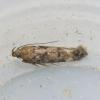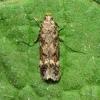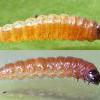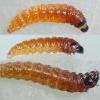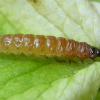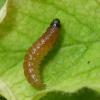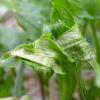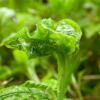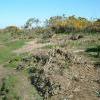35.132 Caryocolum fraternella (Douglas, 1851)
Status and Distribution
Locally common over much of England, particularly in the south and south-east, and south-east Wales. Local to very local in the south-west of England, including the Isles of Scilly, the rest of Wales, Ireland, Northern Ireland and southern Scotland; found for the first time in Angus (VC90) in August 2018 and Fife (VC85) in 2019. Not recorded from the rest of Scotland, Isle of Man and south-west Wales. The national vice county maps suggest it has been noted on the Channel Islands but the data supporting this is unknown.
Provisional map
Foodplant and Larval Feeding Signs
Stellaria uliginosa (bog-stitchwort), see plant distribution map, S. graminea (lesser stitchwort), S. holostea (greater stitchwort), Cerastium arvense (field mouse-ear) and C. fontanum (common mouse-ear). Found on Stellaria nemorum (wood stitchwort) on the Lancashire / Cheshire border in 2007 and again in 2015 (Ben Smart).
Habitat
Finding the Moth
Larva: from early April to late May in a spun young shoot causing a gall-like growth; will vacate the shoot once consumed and proceed to a fresh one.
Adult: flies by night and comes freely to light occasionally a kilometre or more distant from locations where the foodplants occur.
Similar Species
C. viscariella is slightly larger but has considerable overlap in size (wingspan 10-14mm as opposed to 9-13mm in C. fraternella). The dark bar on the forewing from the costa (leading edge) to the fold (near the middle) is usually lost in the general dark colouration extending along the costa in C. fraternella whereas it can be seen to reach the costa in most fresh C. viscariella. The warm yellow lower surface of segment two of the labial palps in C. fraternella is distinctive to that species in Britain whereas in C. viscariella it is yellowish-cream coloured below with heavily blackish brown mottling.
C. alsinella also has significant overlap in size but is generally smaller. C. fraternella has more extensive orange-brown scaling and usually the costal and tornal spots are separated.
Dark specimens of C. marmorea usually have the costal and dorsal white spots much reduced and the underside of segment two of the labial palps is usually ochreous.
Genitalia differences between the three species above and C. fraternella are distinctive and should be used to confirm an identification when worn specimens are encountered or there is any uncertainty due to the variability of forewing markings and size.
Single brooded from late June to the end of August
Earliest: 11th June 1973 (VC1)
Latest: 10th September 1982 (VC66)

